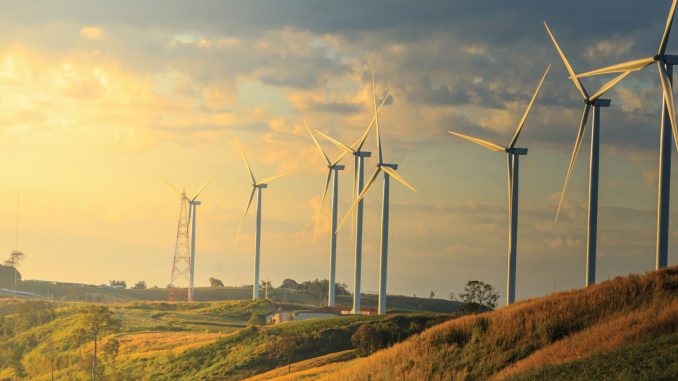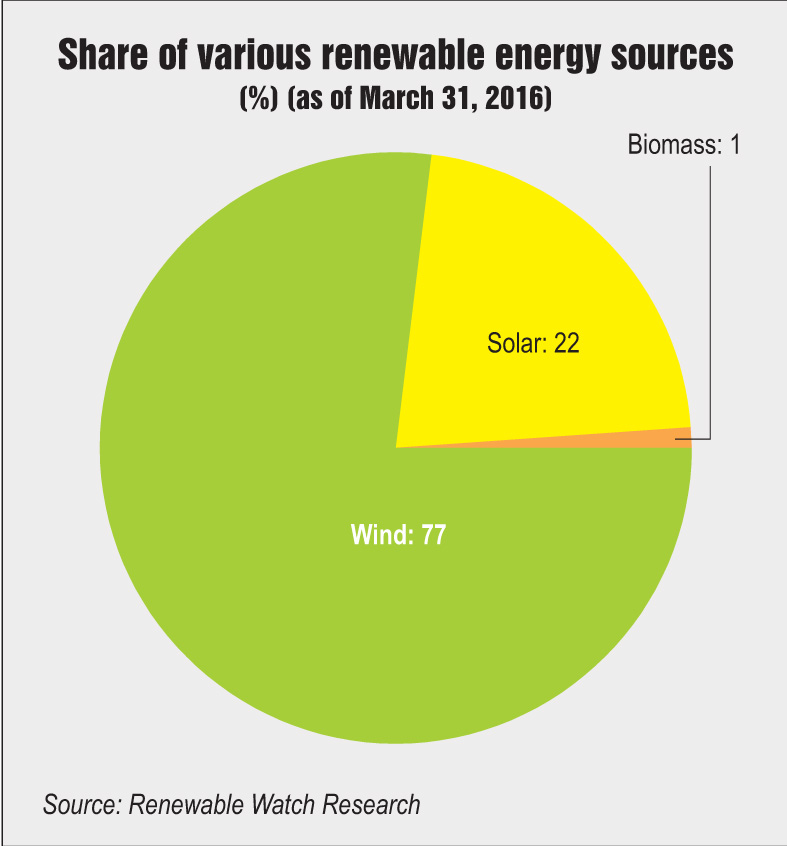
Gujarat is widely known as the flag-bearer for renewable energy development in the country. With the first-ever state solar policy in the country announced in 2009, and several subsequent successful renewable energy policies, Gujarat has witnessed significant capacity addition in the past. The strong policy environment along with the state’s large renewable energy potential – the second highest in the country – augurs well for Gujarat’s renewables’ future.
According to the Ministry of New and Renewable Energy (MNRE), Gujarat has the third highest installed solar power capacity at 1,138 MW as of October 31, 2016, following Tamil Nadu and Rajasthan. In the wind power segment, the state has the fourth highest installed capacity at 3,948 MW as of March 31, 2016, following Tamil Nadu, Maharashtra and Rajasthan. In addition, it has 41 MW of biomass power capacity.
While these are significant achievements, the state is still far behind in achieving its target of 8,020 MW of solar, 8,880 MW of wind, 288 MW of biomass and 25 MW of small-hydropower capacity by 2022.
Gujarat has been defaulting on its renewable purchase obligations (RPOs) for the past six years, though it has met its solar targets to a great extent. During 2015-16, state and private discoms fully met the solar RPO target of 1.5 per cent, achieving 1.92 per cent and 1.55 per cent respectively. However, as against a non-solar RPO target of 7.5 per cent, private discoms achieved 7.78 per cent while state discoms achieved 5.8 per cent. For 2016-17, the solar and non-solar RPOs have been set at 1.75 per cent and 8.25 per cent respectively. Being a power-surplus state, Gujarat does not have any motivation to incentivise developers to increase the renewable energy capacity, which is not in line with the centre’s increased emphasis on renewables.
Solar
The state’s installed solar power capacity has more than doubled, from 554 MW in 2011-12 to 1,120 in 2015-16. As of October 31, 2016, this capacity stood at 1,138 MW, accounting for over 13 per cent of the total installed solar capacity in the country. However, the power-surplus situation in the state has slowed down large-scale capacity addition and shifted the focus to installing small-scale canal-top projects and decentralised solar-powered lighting projects.
Gujarat released the country’s first state solar policy in 2009. The state, along with developing large, megawatt-scale projects, has developed first-of-their-kind projects such as solar parks and canal-top projects. The first solar park was set up in Charanka village with a total capacity of 500 MW. Given its success, a second solar park, to be located in Banaskantha district with a total capacity of 700 MW, has been sanctioned. This solar park will be developed by Gujarat Power Corporation Limited.
Post the expiry of the policy in 2014, the state government released a new policy in 2015, which will be effective till March 2020. The Gujarat Solar Power Policy, 2015 is aimed at promoting several modes of generation, including rooftop solar power for house/building owners, distribution of solar-powered pumps to farmers and stand-alone photovoltaic systems for domestic use.
Along with attracting interest for new projects, the state is attracting investments for setting up manufacturing facilities for solar. For instance, in April 2016, Adani Enterprises received approval from the Gujarat government to set up a solar plant equipment manufacturing facility at Mundra. The company plans to invest $2 billion in setting up the facility with a capacity to manufacture 3,000 MW of solar panels, for which it has set up a special purpose vehicle, Mundra Solar Private Limited. The facility is likely to be built over a period of three years.
Wind
As per an assessment by the National Institute of Wind Energy (NIWE), Gujarat has a wind power potential of 84,431 MW (at 100 metres hub height). Against this, the state has an installed capacity of 3,933 MW as of March 31, 2016. Of this, the cumulative installation during the period April 2012 to December 2015 was 948.23 MW, accounting for around 25 per cent of the cumulative installed capacity. This increase in wind capacity installation can be attributed to the conducive policy and regulatory environment created in the state, as well as the fiscal incentives offered by the central government.
Following the expiry of the state’s Wind Power Policy, 2013 on June 30, 2016, the state government released the Gujarat Wind Power Policy, 2016, which will remain applicable for a period of five years, till June 30, 2021. The new policy makes provision for competitive bidding in the wind segment. Competitive bidding is expected to promote cost-effective procurement of wind power by distribution licensees, apart from protecting consumer interests.
The policy also promotes grid stability and security. It states that the Central Electricity Authority (Technical Standards for Connectivity to the Grid) Amendment Regulations, 2013, as well as the Grid Code will be binding on wind projects commissioned under the policy. Project developers will be required to give their forecast, and energy will be scheduled for day-to-day operations. Another key positive of the new policy is the provision for the micro, small and medium enterprise (MSME) sector. The policy allows MSMEs to set up capacity equivalent to 100 per cent of the contracted demand or sanctioned load of consumers for captive use.
While the policy has a number of positives, it also has a few shortcomings. It states that the evacuation facilities from the wind farm substation to the Gujarat Energy Transmission Corporation (GETCO) substation will be erected by the developers at their own cost. In comparison, under the previous policy, developers would bear the cost of erection only up to 100 km and beyond this limit, GETCO would erect the evacuation facilities. Further, as per the new policy, the wind turbine generators should be integrated by wind farm developers with the installation of remote terminal units at their own cost. This will ensure that injection can be monitored at the connectivity substation by the state load despatch centre on a real-time basis.
With the longest coastline of 16,000 km in the country and a high wind potential, Gujarat is one of the states best suited for the development of offshore wind projects. While the concept has picked up in a number of countries worldwide, it is still at the initial stages in India. In the past, Suzlon had announced plans to develop 5,000 MW of offshore wind projects along the 200 km long coastal belt in the Kutch-Saurashtra region in Gujarat.
More recently, the Global Wind Energy Council, which has been working on the Facilitating Offshore Wind in India (FOWIND) project for the past three years, reportedly stated that the first offshore wind research platform will be set up off the Gujarat coast as part of the project. The platform is being developed jointly by the FOWIND consortium, the MNRE and NIWE with the National Institute of Ocean Technology providing technical support. The project aims to undertake techno-commercial studies to showcase the potential of offshore wind projects, create strategic partnerships, and develop an offshore wind outlook and development pathway for India up to 2032.
Solar-wind hybrid
Owing to the large number of advantages offered by solar-wind hybrid systems, the state released its draft Wind-Solar Hybrid Power Policy, 2017. The policy aims at providing a framework for the promotion of large grid-connected wind-solar systems for optimal and efficient utilisation of transmission infrastructure and land. It also aims to promote the inclusion of new technologies, such as energy storage systems, for efficient functioning of these plants. This policy will be in operation for five years from the date of issuance. The Gujarat Energy Development Agency will be the nodal agency for the facilitation and implementation of the policy.
The policy has attracted interest from various stakeholders in the industry and several companies have proposed to set up wind-solar hybrid projects in the state. Adani Green Energy reportedly has plans to sign agreements for a solar power plant in Patan district, as well as a wind project and a solar-wind hybrid project in Kutch. The cumulative investment proposed by Adani Green Energy is Rs 130 billion. In addition, Gamesa Renewable Private Limited is reportedly considering an investment of Rs 158 billion for establishing manufacturing units in Gujarat for wind, solar, and wind-solar hybrid projects.
Other renewable energy sources
In terms of other renewable energy sources, the state has to increase its current installed biomass capacity of 41 MW sevenfold to 288 MW by 2022 to reach the target set by the central government. In addition, it has to establish 25 MW of small-hydro capacity by 2022.
For the waste-to-energy segment, the state released the Waste to Energy Policy, 2016. The policy is intended to facilitate and promote the utilisation of municipal solid waste for generation of electricity at an affordable cost and in a sustainable manner. Under this policy, only new plants and machinery will be eligible for incentives. Urban local bodies will provide municipal solid waste to plant developers at site free of cost and land will be made available to plant developers at a token annual rent of Re 1.
The way forward
Gujarat is the leading state in the country in terms of renewable energy initiatives and policies. The state has the potential to become a net exporter of clean power to other states and hence should continue its efforts to grow its installed renewables capacity. Considering the significant potential of renewable energy sources in the state and given the impetus being provided to upcoming concepts such as wind-solar hybrids and offshore wind, there is clearly enormous scope for renewables growth in the state.
By Jyoti Yadav






